All of us must be aware of certain actions that have to be performed when taking darshan (A view of the Deity) in a Devalay, like removing one’s footwear, doing Namaskar at the main entrance of the temple, etc. Many a times, questions may have arisen in our minds as to what could be the reason behind these actions. Based on the knowledge provided by the Hindu scriptures, the following article answers some of these questions.
1. What is the reason for removing all objects made of leather before entering the Devalay?
Since leather objects are made from the Raja-Tama predominant hide of animals, they emit Tama-predominant waves, which create a sheath around the body of the individual. This sheath reduces the ability of the individual to absorb the sattvikta present in the environment of the Devalay. As a result, the individual gets proportionately less benefit of the sattvikta present in the Devalay. Hence, as far as possible, avoid wearing leather objects (such as waist belt etc.) on the body that create an obstruction for the sattvik waves, while entering the sattvik environment of the Devalay.
2. Why should we remove our footwear before entering a Devalay?
A. Wearing of Raja-Tama predominant objects like sandals and shoes facilitates the entry of waves, which flow from the earth to Patal (Hell region) into the Devalay and thereby reduces or destroys the sattvikta within the Devalay
Devalay is a centre for collective worship. For all to get utmost benefit of the Chaitanya (Divine consciousness) emitting from the Devalay, it is incorrect to visit a Devalay wearing Raja-Tama predominant and dusty objects like sandals and shoes. They can facilitate the entry of waves flowing from the earth to Patal (Hell Region) into the Devalay and thereby reduce or destroy the sattvikta within the Devalay. Should the prevalence of waves connected with Patal increase on the outskirts of Devalay, in a way there is a likelihood of developing a subtle Patal. Therefore, as far aspossible avoid wearing such objects while visiting a Devalay. Footwear should not be removed even in the Devalay premises, because of the presence of waves of Deities and their ganas (Assistants); especially in a Shiva Devalay, where His ganas are always present. Removal of footwear in the premises leads to the development of a sheath of Raja-Tama particles over the sattvik waves emitting from the Deity’s Idol. This reduces the sattvikta of the area and the individual also does not benefit from the sattvikta. Besides, if any gana (Assistant) becomes angry, the individual may have to face its wrath and suffer spiritual loss. To avoid this spiritual loss, do not remove your footwear in a Devalay premises; remove them outside the premises instead. If this is not possible or if the Devalay is on the roadside, you should enter the Devalay only after a sincere prayer asking for forgiveness to the Deity.
B. Picture based on subtle-knowledge depicting adverse effects of having darshan in a temple with the footwear on
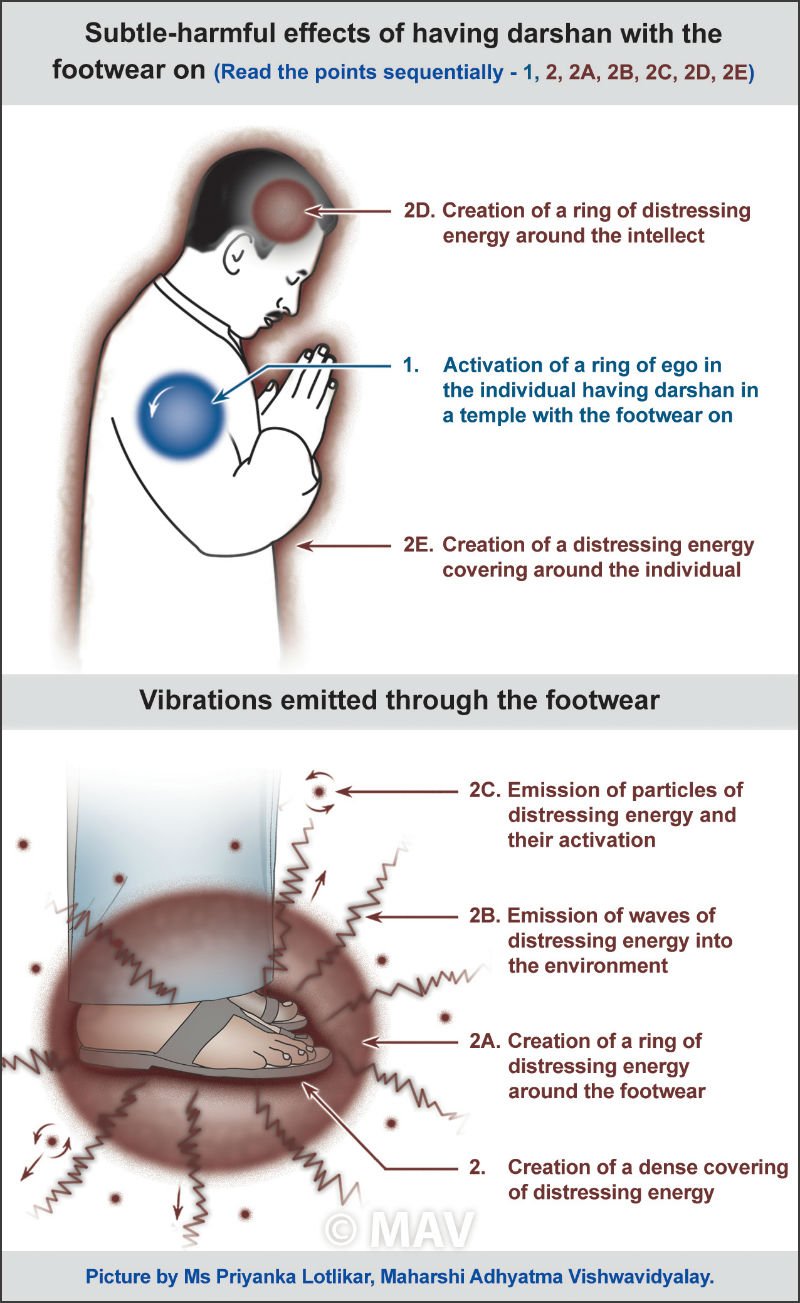
-
Since the footwear is made from Tama-predominant material, Tama-predominant vibrations from the environment are instantly attracted to it : Footwear is made from Tama-predominant material like rubber, leather etc. Consequently, Tama-predominant vibrations from the environment are instantly attracted to it. This is akin to like-minded people getting instantly attracted to each other and their thoughts matching.
-
Due to dust particles in the footwear, even negative energies in the environment are attracted to it.
-
Due to the footwear, since black energy in them continually spreads into the person’s body, he is unable to absorb the vibrations emanating from the Deity of the temple. As a result, he does not benefit from the darshan of the Deity.
-
A person who has darshan in the temple with his footwear on does not have bhav (Spiritual emotion) towards the Deity. The person may incur sin by performing this inappropriate action.
-
A person who has darshan in a temple barefooted obtains the Earth Principle from the Holy premises of the temple and also gets the benefit of its Holy waves.
C. Walking barefoot in the Devalay premises attracts waves which reduce body heat
It is easy for the highest order of sattvik and Chaitanya laden waves present in the earth at places of pilgrimage, areas surrounding the Devalays, and while having darshan of a Saint, to enter the body through the feet. Since the feet do not touch the earth while wearing shoes at such places, an individual is not able to imbibe the waves in the earth and hence, its sattvikta also does not increase. The earth in places of pilgrimage is cool due to the presence of Chaitanya there. By touching the ground, the cool waves come into contact with the feet and are attracted into the body. They spread in the body and reduce the body heat. That is why, Dharmashastras recommend that one should walk barefoot in places of pilgrimage, areas surrounding the Devalays, and while having darshan of a Saint.
D. Do not remove the footwear right in front of the Devalay
Many people remove their footwear in front of the Devalay. As a result, a subtle wall of Raja-Tama particles emitting from the footwear gets formed, which obstructs the Chaitanya emitting from the Devalay, and gets directed inside again instead of going out. Hence, an individual standing outside the Devalay does not get the benefit of the Chaitanya emitting from the Devalay. To avoid this, remove the footwear towards the right side of the Devalay.
The removal of footwear on the line in front of the Devalay leads to creation of a subtle-line, which resembles the subtle-line of the Patal region; as a result, the extremely hot flows of black fibres flowing along the subtle line of Patal get activated on the line formed by footwear and block the flow of waves emitting from the Devalay.
Question: ‘Why is the wall of Raja-Tama formed if footwear is placed in front of a Devalay? Why are the Raja-Tama predominant waves not destroyed by the waves emanating from the Deity?
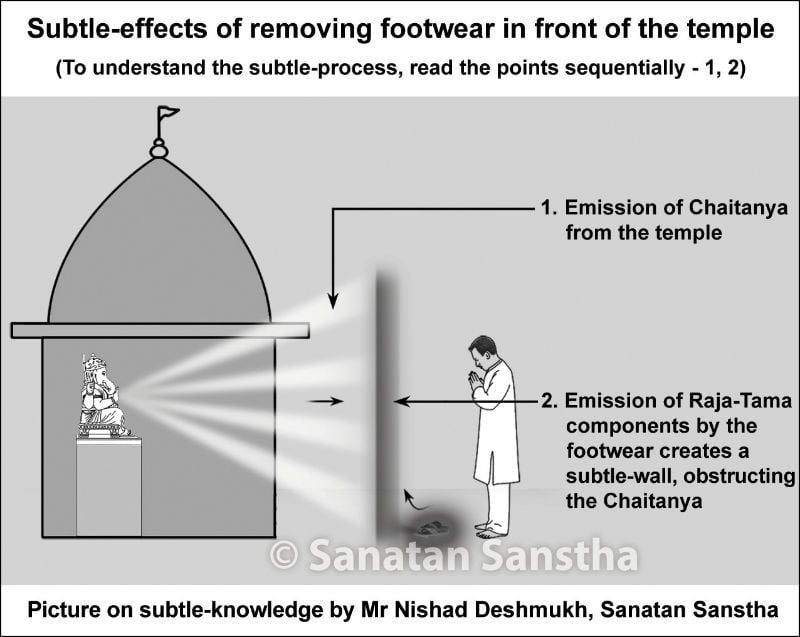 Answer: The removal of footwear on the line in front of the Devalay leads to creation of a subtle-line. This line develops a resemblance to the subtle central line of the Patal region. The Raja-Tama particles from the footwear form a pull exerting field like a whirlpool, that unites the line from the Patal region and the line of the footwear in equal proportion. This further leads to streams of very hot black energy fibres flowing on the line of Patal region, gaining momentum on the line formed due to the footwear. This blocks the flow of sattvik waves coming from Devalay. The flow of sattvik waves emitting from the Idol, though beneficial, is not strong enough to oppose the original line of Patal and hence, the restrictions on their movements.
Answer: The removal of footwear on the line in front of the Devalay leads to creation of a subtle-line. This line develops a resemblance to the subtle central line of the Patal region. The Raja-Tama particles from the footwear form a pull exerting field like a whirlpool, that unites the line from the Patal region and the line of the footwear in equal proportion. This further leads to streams of very hot black energy fibres flowing on the line of Patal region, gaining momentum on the line formed due to the footwear. This blocks the flow of sattvik waves coming from Devalay. The flow of sattvik waves emitting from the Idol, though beneficial, is not strong enough to oppose the original line of Patal and hence, the restrictions on their movements.
E. If it is unavoidable to remove footwear within the Devalay premises, then remove them on the right side of the Deity

Since samashṭi (For the welfare of the society) task takes place in the Devalay, the tarak (Saviour) side (that is, the Sun channel) of the Devalay’s presiding Deity is always in an awakened state. Therefore, there are warm waves outside the Devalay. They disintegrate the Raja-Tama component being emitted by the footwear kept outside the Devalay. Also, since the act of destroying the Raja-Tama predominant waves gets localised (in the area where footwear are kept), the waves emitting from the Deity are better charged with activity and are emitted in a larger proportion.
(Inferior level action such as destroying Raja-Tama emanating from the footwear is a mission of the Deity’s tarak form only. Destruction of the higher level negative energies is a mission of the Deity’s marak [Destroyer] form.)
3. Why do we need to wash our feet before entering a Devalay?
Washing the feet before entering a Devalay increases an individual’s ability to absorb the sattvik waves and maintains the sattvikta of the Devalay
‘When walking on the road, fine particlesof dust stick to the feet / footwear. It is because of the Raja-Tama predominant waves emitting from the dust particles, that entering the Devalay without washing the feet reduce the individual’s capacity to absorb the Sattva-predominant waves. Also, due to the emission of Raja-Tama predominant waves into the environment, the Sattva predominance of the Devalay is reduced. On the other hand, entering the Devalay after washing the feet removes the obstacle (dust particles) in receiving the sattvik waves. Additionally, reduced emission of the Raja-Tama predominant waves in the atmosphere helps maintain the sattvik environment of the Devalay.
(Earlier, Hindus used to wash their feet in a pond outside the Devalays before entering them. Now-a-days, most Devalays either do not have such ponds or people are not aware of the importance of washing their feet before entering a Devalay, that is, they lack religious understanding and hence, they enter the Devalay without washing their feet. This is one of the reasons for the reduction in the sattvikta of Hindu Devalays.)
4. Why should we not cover the neck with a cloth while having darshan of the Deity and the Guru?
To benefit 100 percent from each sattvik wave and sattvik particle emitted by the Deity and the Guru, we should not cover the neck with a cloth
प्रदक्षिणेप्रणामेचपूजायांहवनेजपे ।
नकण्ठावृतवस्त्रःस्यात्दर्शनेगुरुदेवयोः ।।
– Vadhulsmruti, Shloka 140
Meaning : While doing pradakshina, Namaskar and Japa, while performing havan and while having darshan of the Deity and the Guru, we should not cover the neck with a cloth.
The underlying science : When one is performing the actions mentioned above, sattvik waves emitting from the Deity or a Saint revolve around the person in a spherical manner. If the person has good bhav, then these sattvik waves revolve around him for a longer period of time and start affecting the person’s mind and the body. If the person covers the neck with a cloth, then he is not able to benefit from these waves. Also, due to obstruction by the cloth, the Vishuddha chakra(Fifth centre in the spiritual energy system located in the neck in the subtle body) of a person is not awakened, and thus, the sattvik waves are not able to enter his body. Thus, in order to obtain 100 percent benefit from each sattvik frequency and sattvik particle emitted by the Deity and the Guru, we must not cover the neck with a cloth.
Picture based on subtle-knowledge showing the adverse effects of having darshan with a cloth draped around the neck
5. Why should we do Namaskar to the main door of a Devalay and the Garuda-dwaj?
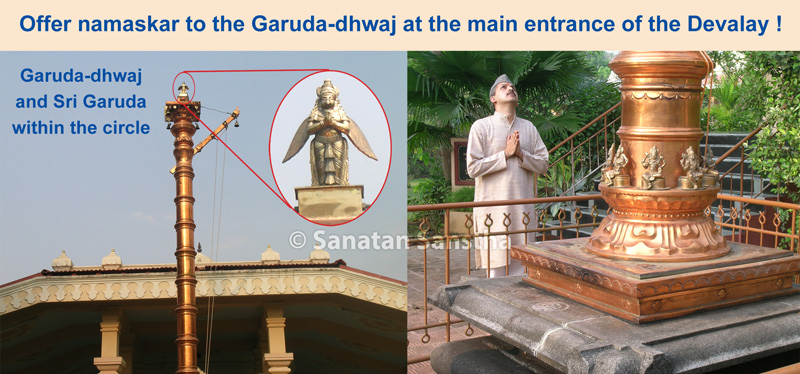
1. Namaskar to the main entrance door of the Devalay and Garuda-dhwaj (Flag with emblem of Garuda [Eagle])before entering the Devalay is like seeking permission for entry in the area of dominance : A Devalay is the seat of Shakti of a Deity; hence, the ganas of the Deity are present in subtle form beside the entrance doors. Therefore, Namaskar to the main entrance door and the Garuda-dhwaj denote seeking permission to enter the Devalay for a darshan of the Deity.
2. Namaskar to the main entrance door and Garuda-dhwaj of the Devalay denote developing the ‘impression of humility’ by the individual for entering into the region of Deities.
3. Namaskar to the main entrance door and Garuda-dhwaj of the Devalay denotes pleading to various inferior waves moving about in the Devalay, through the medium of Namaskar and making an easy entry into the Devalay : Devalay is a home in the manifest form to God’s Dharma oriented Divine set up. Therefore, Shakti always remains active on all the four sides of the Devalay and protects it from attacks of negative energies. When an individual from the outer environment enters the Devalay, which is a source of sattvikta, it encounters the resistance for its entry from the energy that opposes Raja-Tama particles. An individual with a spiritual level of 40% and above can tolerate the opposition and easily proceed inside; but other individuals with lower spiritual levels cannot tolerate the opposition from the Divine Energy and can suffer from distress such as headache, nausea, fatigue and blurring of vision. However, when an individual does Namaskar, the waves opposing the entry get pacified and it can enter the Devalay with ease. Therefore, as far as possible, all visitors should enter the Devalay only after doing Namaskar, according to spiritual science.
4. Namaskar to Garuda-dhwaj : Garuda is a Principle that holds the particles of Dharma associated with Sustenance. Hence, Garuda-dhwaj is found in front of the main entrance doors of all Devalays. The sagun (Materialised) layout of the Devalay, based on particles of Dharma associated with Sustenance and the Divine Principle active within, lasts only in the form defined by their state. At the same time, Garuda emits these particles of Dharma associated with Sustenance in the three dimensions of nature (The flow of energy – at the level of Ichha [Will], Kriya [Action] and Dnyan [Knowledge]) provides Chaitanya to Sattva particles present in the environment. Thus, it also acts as a medium that maintains the environment neutral). Namaskar to the Garuda-dhwaj that carries so much importance amounts to Namaskar to and expressing gratitude towards the Vayu (Absolute Air)-form Divine Principle. Namaskar to Garuda dhwaj suppresses the waste gases present in the outer environment that oppose the entry into the Devalay and thus the individual can enter the Devalay
5. Namaskar to the main entrance door of the Devalay : The Devalay is a sagun form of the region of Deities. Namaskar to the main entrance door amounts to making an impression of humility on the self, before entering the region of Deities and receiving their blessings. The act of Namaskar generates Divine qualities in the subconscious mind of the individual, as a result the Deity’s blessing get attracted towards the This enables the individual to imbibe sattvikta without encountering any resistance.
Reference : Sanatan’s Holy Text, ‘How should one have darshan in a temple?’

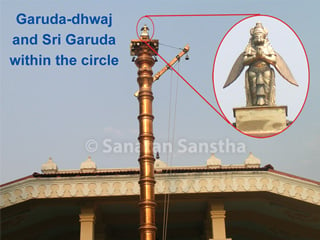
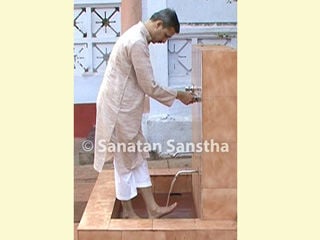
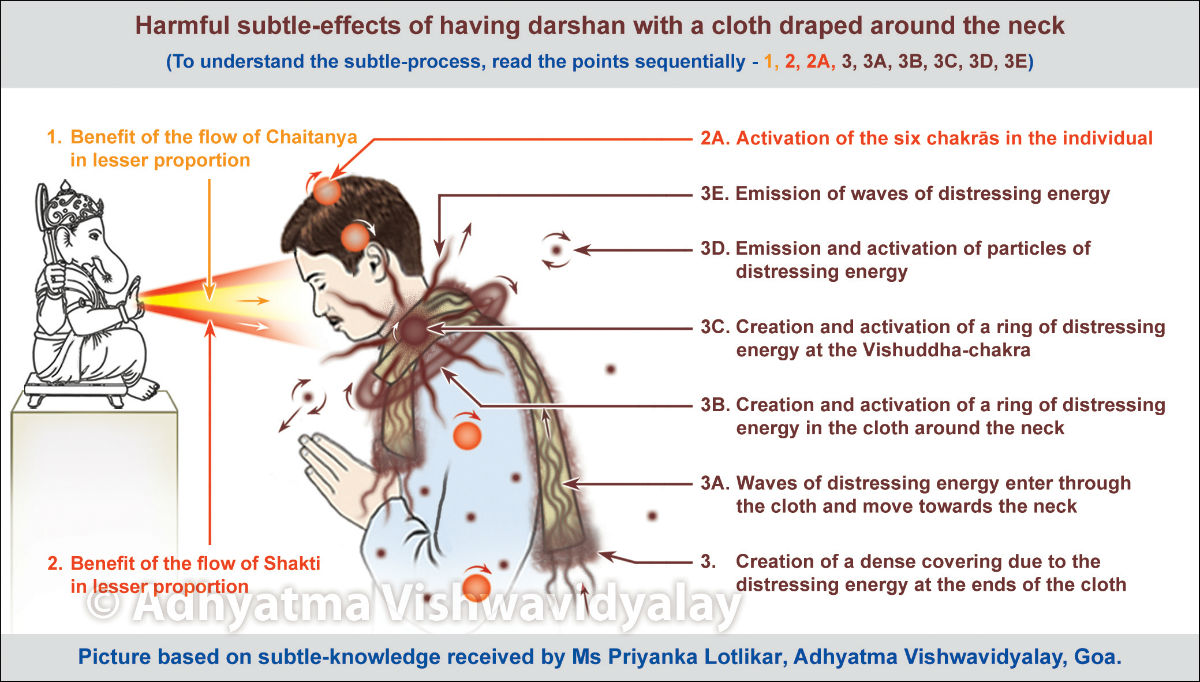
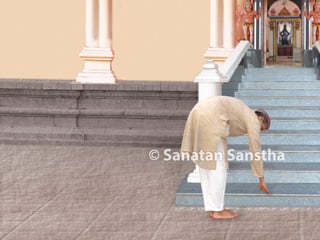 The correct method of having darshan in a Devalay (Temple)
The correct method of having darshan in a Devalay (Temple)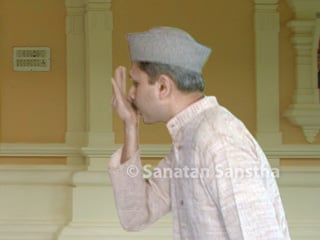 Partaking Tirth and Prasad
Partaking Tirth and Prasad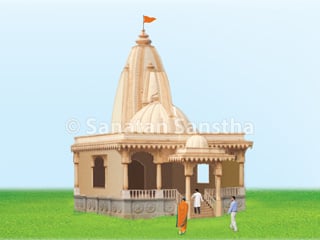 Importance of having darshan in a Devalay (Temple)
Importance of having darshan in a Devalay (Temple) Performing Pradakshina (Circumambulation) of a Deity
Performing Pradakshina (Circumambulation) of a Deity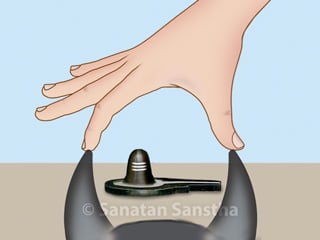 Importance of taking darshan of Nandi before darshan of the pindi in Deity Shiva’s Devalay
Importance of taking darshan of Nandi before darshan of the pindi in Deity Shiva’s Devalay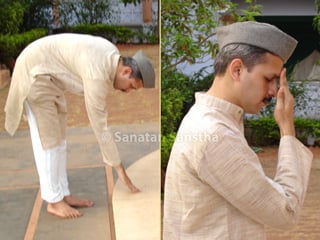 Visiting a Hindu temple - How to take benefits spiritually
Visiting a Hindu temple - How to take benefits spiritually